Jay Heritage Center
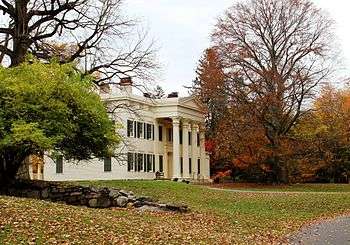
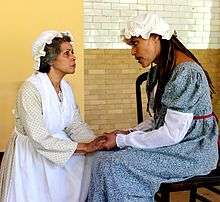
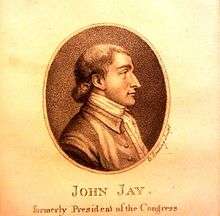
The Jay Heritage Center (JHC).[1][2] is a 501(c)(3) not-for-profit organization incorporated in 1990 and chartered by the New York State Board of Regents to act as stewards of the Jay Estate, the National Historic Landmark home of American Founding Father John Jay. Jay's ancestral property in Rye, New York is considered the centerpiece of the Boston Post Road Historic District.
Mission, Programs and Events
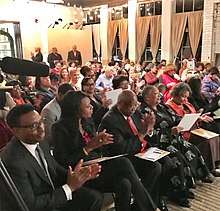
The Jay Heritage Center's mission is to educate the public about the legacy of American patriot, jurist, anti-slavery advocate and diplomat John Jay through the historic preservation, restoration and interpretation of the land upon which he grew up in Rye, New York.[3] Jay's character was influenced by this touchstone throughout his formative youth and early career; he would return to it frequently as a place of both contemplation and celebration.
JHC manages the remaining 23-acre (9.3 ha) core parcel of Jay's home as an educational center with programs in American history, architecture, social justice, landscape conservation and environmental stewardship. JHC's signature educational program Striving For Freedom is a site-specific, interactive play based on historic records which engages 4th grade to 7th grade students in a discussion of Jay's role in the abolition of slavery in New York State. The program is provided free and often free bus transportation is provided as well for qualifying Title 1 schools.[4] The play has been performed for over 15 years. JHC was also named to New York State's Path Through History in 2014 for its programs that explore themes of Civil Rights as reflected in the legacy of the Jay family.[5]
Other popular school and family programs have included hands-on archaeology digs, architecture mini-camps and "Our Footprints Matter", a program about sustainability which highlights the energy efficient measures employed by JHC.[6]
Through collaborative partnerships, JHC is a co-sponsor of the Martin Luther King Jr. Literary Celebration (January), Annual African American Trailblazers Awards Ceremony (February), I Love My Park Day (May) and Hudson River Valley Ramble (September)
History
The Jay Heritage Center was an outgrowth of the civic advocacy of the Jay Coalition, a group of more than 62 historical and environmental organizations dedicated to protecting John Jay's ancestral home in Rye.[7] It has also contributed to the preservation of the surrounding historic district. In 2005, J. Winthrop Aldrich, former assistant to six successive Commissioners of New York State Department of Environmental Conservation (1974–94) and Deputy Commissioner New York State Office of Parks, Recreation and Historic Preservation (1998-2003; 2007–10) attested that the effort "to preserve, restore and interpret the properties has been a model for the nation." [8]
Stewardship of the Jay Estate – landscape and buildings
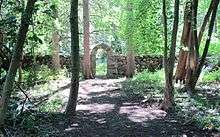
JHC is one of three owners of this parcel of public parkland that overlooks Long Island Sound. JHC owns 1.5 acres (0.61 ha) and the New York State Office of Parks, Recreation and Historic Preservation (NYSOPRHP) and Westchester County Parks share interest in the remaining 21.5 acres (8.7 ha) (with NYSOPRHP owning 90% and Westchester County Parks owning 10%). In August 2013, JHC was awarded management of the Jay Estate by NYSOPRHP and Westchester County Executive Rob Astorino through a public-private partnership agreement.[9] The agreement had previously received unanimous and bipartisan support from the Westchester County Board of Legislators in November 2012.[10] NY State Parks Commissioner Rose Harvey commented on the agreement in a lecture titled Stewardship of New York's Cultural and Natural History on April 29, 2014. The Commissioner articulated the importance of saving the site: "Here we are at the boyhood home of the only native founding father and the first Chief Justice of the United States, author of New York's constitution and two time governor, abolitionist and patriarch of several generations of similarly public minded descendants. It is a reminder of how many leaders called New York home and it is a source of state pride that we have preserved this home."[11]
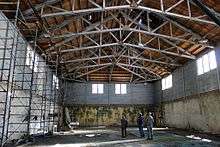
JHC is entrusted to stabilize and rehabilitate culturally significant landscape features at the Jay Estate including 1822 stone ha-ha walls, 1.5 acres (0.61 ha) of historic sunken gardens that date back to the 1700s, a meadow, an apple orchard, and elm tree allée. JHC was awarded a $500,000 Regional Economic Development Council (REDC) grant in December 2014 to help restore the historic Jay Gardens.[12][13][14]
JHC is also overseeing restoration and rehabilitation of several historic buildings. JHC owns two of the buildings outright – the 1838 Peter Augustus Jay House and the 1907 Van Norden Carriage House. The Carriage House was designed by the architect Frank A. Rooke[15] who designed Claremont Stables and several Sheffield Farms dairy plants in Manhattan. Commissioned by the later residents Warner and Grace Talcott Van Norden, the Classical Revival, yellow folly has its original, four-faced Seth Thomas clock and three pairs of mahogany pocket doors.
The remaining buildings – the 1907 Zebra House, Jay Ice House, 1917 Indoor Tennis House, and an 18th-century farmhouse – belong jointly to New York State Parks and Westchester County Parks but are being managed and restored by JHC. On August 4, 2015 Governor Andrew Cuomo announced more than $6.2 million in grant awards to help 16 historically significant properties repair severe damage from Superstorm Sandy in 2012; JHC was one of those organizations and awarded $391,056 for stabilization and restoration of the 1917 Palmer Tennis House which is also in its care. "The Palmer Tennis House, the third oldest indoor tennis court in the United States, experienced roof damage during Hurricane Sandy. The Jay Heritage Center will stabilize and restore the wood truss system and copper trimmed skylights, as well as the stone foundation and clapboard siding. Improvements to the tennis house, constructed circa 1917, will facilitate historic usage and interpretation."[16]
Notable Speakers
Notable programs for adults at the site have featured Lincoln historian Harold Holzer, American essayist Adam Gopnik, constitutional scholar Akhil Reed Amar, Pulitzer Prize-winning authors Ron Chernow, Annette Gordon-Reed, Joseph Ellis and Alan Taylor, historians Joanne B. Freeman, Barry Lewis and Peter S. Onuf, American author and activist Hugh Bernard Price, landscape preservationists Elizabeth Barlow Rogers and Lynden B. Miller, jurists Jonathan Lippman and Janet DiFiore and the late Roger G. Kennedy, former Director of the National Museum of American History who helped outline an interpretative plan for JHC in the early 1990s. Children's programs have welcomed illustrator Barry Blitt, historian Jonah Winter, pop-up engineer Robert Sabuda and artist Herve Tullet.
Exhibits

Past exhibits have included A Legacy of Sailing – Residents of the Jay Estate and Yachting New York 1843–1966, which coincided with New York State's Hudson-Fulton-Champlain Quadricentennial celebration and was co-sponsored by Mystic Seaport; The Jays and The Abolition Of Slavery: From Manumission to Emancipation co-sponsored by the New-York Historical Society; and The Landmarks of New York a major exhibit of over 100 black and white photographs of iconic structures saved through preservation advocacy. Most recently the exhibit Mary Rutherfurd Jay – Garden Architect (1872–1953) illustrated the life and career of one of America's earliest landscape architects and proponents of professional education for women.
Jay Medal
In 2012, JHC created "The John Jay Medal For Service" "to recognize individuals who demonstrate a selfless spirit of commitment and engagement with their community." JHC Founder Catherine "Kitty" Aresty and New York preservation advocate Barbaralee Diamonstein-Spielvogel were the first recipients of the Medal awarded by Congresswoman Nita Lowey.[17] 2016 Honorees were Joseph Ellis, author of Founding Brothers and environmental lawyer Nicholas A. Robinson.
Honors
Members of the JHC Board have been honored for their service in building awareness about the historical significance of John Jay's legacy and home in Rye by a number of organizations including the Garden Club of America, African American Men of Westchester and Parks & Trails New York.[18]
References
- ↑ "At the Jay Heritage Center in Rye: Young Americans". The New York Times. 13 March 2016. Retrieved 31 July 2016.
- ↑ "What's a Historic House You Can't Enter in Style?". The New York Times. 2 March 2008. Retrieved 31 July 2016.
- ↑ Examining John Jay's Legacy at the Jay Heritage Center and the Jay Homestead. YouTube. 3 May 2010.
- ↑ "School Programs and Striving for Freedom".
- ↑ "New York State's Path Through History".
- ↑ Lowey, Congresswoman Nita "Jay Heritage Center to Become Energy Efficient", 8/11/08 Archived 2014-12-20 at the Wayback Machine.
- ↑ Melvin, Tessa,"A Purchase Agreement for Jay Land", The New York Times, New York, July 12, 1992.
- ↑ "Rye City Commission Planning Minutes, March 8, 2005" (PDF). Retrieved March 18, 2018.
- ↑ Rae, Leah, "John Jay center takes over upkeep of mansion's grounds, plans educational campus," 'The Journal News,' Westchester County, New York, October 6, 2012
- ↑ "ACT-2012-173 Jay Property Estate Restoration/Maintenance – Westchester County, New York". iqm2.com.
- ↑ The John Jay Lecture by NY State Parks Commissioner Rose Harvey. YouTube. 3 July 2014.
- ↑ "2014 Regional Economic Development Council Awards Booklet, p.101" (PDF). Retrieved 31 July 2016.
- ↑ "Jay gardens in Rye to get $1.5 million makeover". lohud.com. 27 February 2015.
- ↑ Aaron Elstein (26 August 2015). "The New York Public Library is digitizing its collection of 435,000 maps – Crain's New York Business". Crain's New York Business.
- ↑ "Zebra Testing Scheme" 'Amsterdam Evening Recorder', New York, New York, November 15, 1906. See newspaper page.
- ↑ "Governor Cuomo Announces $6.2 Million in Grants For Historic Properties Damaged By Superstorm Sandy". Governor Andrew M. Cuomo.
- ↑ "Anniversary celebrations and celebrity conversations". New York Social Diary.
- ↑ "Parks & Trails New York Honors Park and Trail Heroes at Albany Reception," June 10, 2015